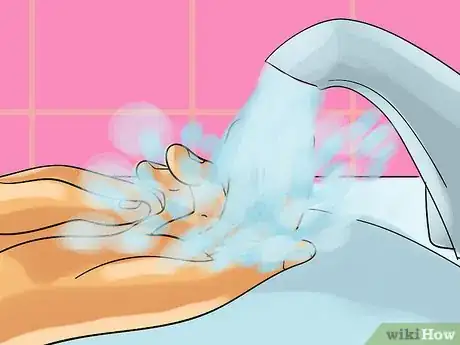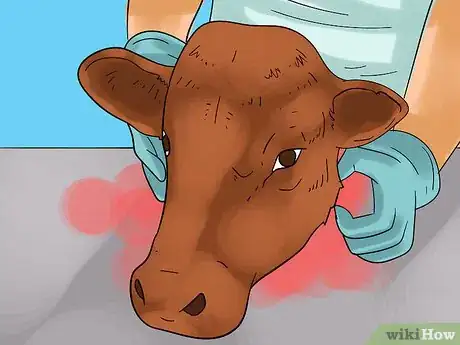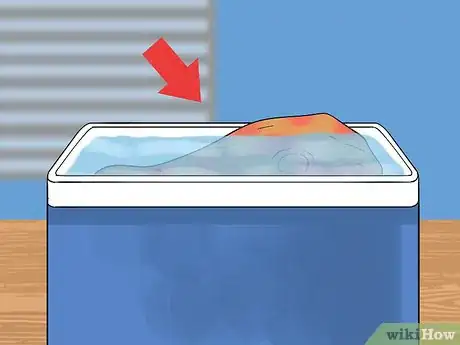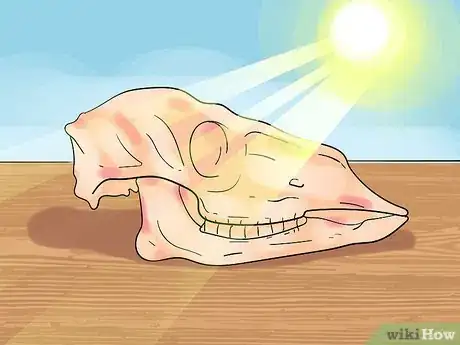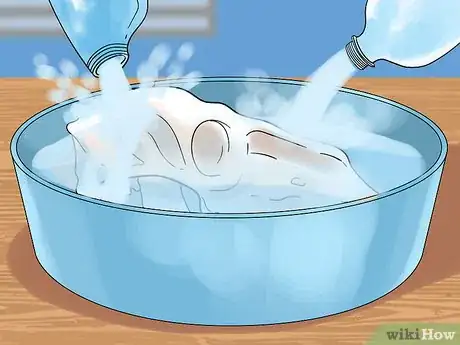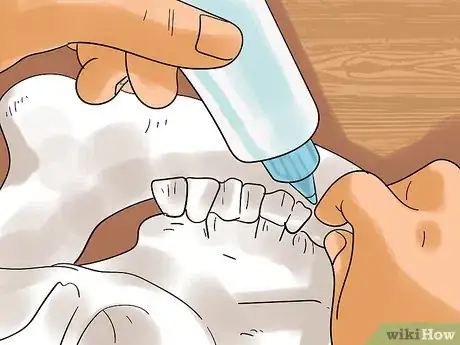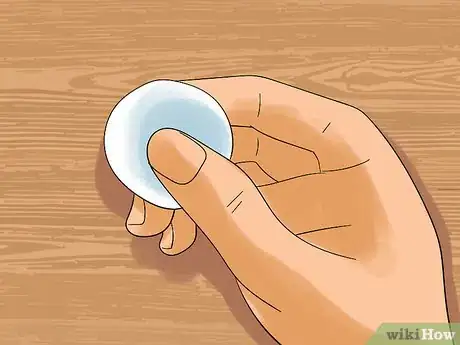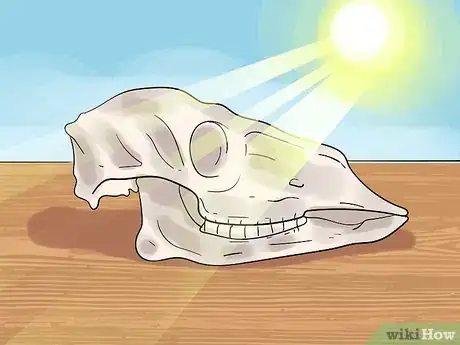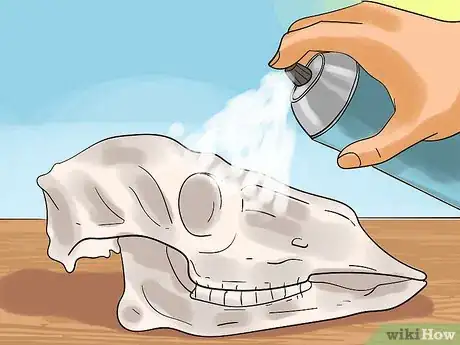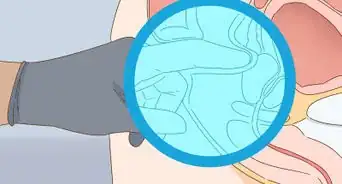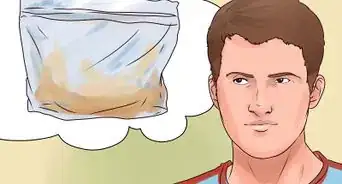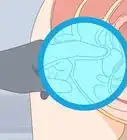This article was co-authored by wikiHow Staff. Our trained team of editors and researchers validate articles for accuracy and comprehensiveness. wikiHow's Content Management Team carefully monitors the work from our editorial staff to ensure that each article is backed by trusted research and meets our high quality standards.
wikiHow marks an article as reader-approved once it receives enough positive feedback. In this case, 94% of readers who voted found the article helpful, earning it our reader-approved status.
This article has been viewed 449,182 times.
Learn more...
A cleaned animal skull can make a beautiful and unique ornament for a wide range of art products. They can also teach us a lot about the animals themselves. Age, habits, even how they died can be determined through the skulls and bones. An animal skull must be totally clean prior to preservation and there are several methods that can be used. Here are the steps to follow in order to learn how to clean and preserve a skull.
Steps
Removing the Flesh
-
1Take precautions for preventing zoonosis. Many diseases that animals carry, such as rabies, can be transmitted to humans. These are called zoonotic diseases. These diseases may remain intact even after the death of the animal. Take precautions with this in mind.[1]
- Wear gloves and thoroughly wash your hands, arms or any other body part that comes into contact with the carcass.
- You may also want a surgical mask during the flesh removal process.
-
2Macerate the skull. Maceration refers to the removal of flesh from a dead animal. You’ll need to remove flesh from both inside and outside the skull by placing it in a bucket or large plastic bin with an enzyme-based laundry detergent. There are several methods available.[2]
- Cold water maceration is a long process that involves letting the skull soak in room temperature water with a small amount of cold-water laundry detergent. These detergents have enzymes that will break down organic matter. This is the safest way to clean the skull and leave it intact. This can take from a few days to a few weeks to complete, depending on the size of the skull.[3]
- Hot water maceration, also known as "cooking" the skull, involves placing the skull in hot water with the enzyme detergent and simmering (not boiling) it. You can use a stove top or hot plate. The animal skull needs to be watched carefully, since simmering it for too long or boiling it will damage the skull by cooking the grease into it.[4]
- Another method of removing flesh from bone is to put the skull on top of an anthill be sure to put it in a small cage or otherwise protect it from being damaged or taken by animals. The ants will clean every bit of flesh from the skull without damaging the structural integrity of it.
Advertisement -
3Remove the grease. Take the grease off of the skull by letting it soak for a few days in a mix of water and a little bit of dish detergent that cuts through grease. This process is important because if grease is left in the bone it may start to smell or get a gross build-up of grease on the surfaces of it.[5]
- Use latex gloves when working with the raw material.
- Change the water every day or when it gets cloudy.
- This step is done when the water is clear after a day.
-
4Dry the skull. Make sure that the skull is thoroughly dried out before you begin the bleaching process. Let it air dry for several days.[6]
- Leave the skull on a towel and several sheets of paper towels. Keep it inside so it doesn’t attract scavenging animals or bugs.
Bleaching the Skull
-
1Soak in hydrogen peroxide. Submerge the skull in a large container full of water. Include only 10-15 ounces of 35 percent hydrogen peroxide per approximately 5 liters (1.3 US gal) of water.[7]
- Do not use chlorine bleach, because this can damage bone and teeth.
- This turns the skull a bright white. Skulls are naturally an off-white to yellowish color.
- Leave the skull in the water for at least 24 hours.
-
2Place teeth back into their sockets. If you use one of the water methods for cleaning an animal skull, the teeth will drop out of the tooth sockets. Save the teeth and replace them using a small amount of super glue.[8]
-
3Use cotton on carnivorous teeth. Most animals whose skulls are used in preservation are carnivores and have a set of canine teeth. These teeth have a tendency to be much smaller than the actual socket they fit in.[9]
- Use some cotton balls soaked in glue. Wrap a bit of the cotton around the tooth and insert it into the socket.
-
4Dry the skull. Leave the skull outside for 24 hours to let it dry in the sun and to let the glue set. Because the skull will have no more organic matter attached to it, you don’t have to worry about animals or bugs.
-
5Preserve with polyurethane. Spray the skull with several coats of polyurethane letting each coat dry before applying the next. This leaves a smooth and shiny finish.[10]
Our Most Loved Articles & Quizzes
Community Q&A
-
QuestionI think I have some kind of bug living in my (supposedly) dried skull. I see a lot of bone dust and shed exoskeletons beneath my steer skull. How do I stop the infestation?
 LilyCommunity AnswerSoak your skull in water for several days. If you're worried about germs or other bugs living in your skull, a dip in a peroxide bath will sanitize and kill bugs.
LilyCommunity AnswerSoak your skull in water for several days. If you're worried about germs or other bugs living in your skull, a dip in a peroxide bath will sanitize and kill bugs. -
QuestionHow many specific coats of polyurethane should you spray on the skull?
 Community AnswerStart with 2 coats. Make sure the entire skull is covered.
Community AnswerStart with 2 coats. Make sure the entire skull is covered. -
QuestionCan I do this with a full animal skeleton, such as a full squirrel?
 QueerDeerCommunity AnswerYes, of course! Pretty much every corpse can be macerated and cleaned up in this way. Just be careful, as the smaller the animal, the smaller the bones. Also, make sure to skin it or pluck out as much hair as you can, as it doesn't degrade at all during the process.
QueerDeerCommunity AnswerYes, of course! Pretty much every corpse can be macerated and cleaned up in this way. Just be careful, as the smaller the animal, the smaller the bones. Also, make sure to skin it or pluck out as much hair as you can, as it doesn't degrade at all during the process.
Things You'll Need
- A dead animals head
- A large container
- Water
- Enzyme-activated laundry detergent (it will say Cold Water on the package)
- Hydrogen peroxide
- A can of polyurethane spray
- Latex gloves
- Face mask
References
- ↑ http://www.doh.wa.gov/YouandYourFamily/IllnessandDisease/AnimalTransmittedDiseases
- ↑ https://www2.nau.edu/tct/skullprepuofa.pdf
- ↑ http://extension.arizona.edu/sites/extension.arizona.edu/files/pubs/az1144.pdf
- ↑ http://www.adfg.alaska.gov/index.cfm?adfg=hunting.skull
- ↑ https://www2.nau.edu/tct/skullprepuofa.pdf
- ↑ https://www2.nau.edu/tct/skullprepuofa.pdf
- ↑ https://www.sikkerhverdag.no/en/leisure/sport-and-activities/how-to-clean-and-bleach-animal-skulls-safely/
- ↑ https://www.adfg.alaska.gov/index.cfm?adfg=hunting.skull
- ↑ https://www2.nau.edu/tct/skullprepuofa.pdf
About This Article
To preserve an animal skull, start by placing it in a bucket of cold water and laundry detergent for a few days to remove all the flesh. Next, soak the skull in cold water and dish detergent for 2-3 days to remove grease before letting it air dry for several days. Then, put the skull in a bucket of water and hydrogen peroxide for 24 hours. Finally, leave the skull outside to dry in the sun for 24 hours. For tips on how to put the teeth back in their sockets, read on!
